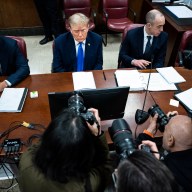 Leonardo DiCaprio and Carey Mulligan play Gatsby and Daisy in “The Great Gatsby.”
Leonardo DiCaprio and Carey Mulligan play Gatsby and Daisy in “The Great Gatsby.”
Credit: Warner Bros. Pictures
What Baz Luhrmann did to F. Scott Fitzgerald’s “The Great Gatsby” has dominated reports on the film: the 3-D, the rap music, the dazzling digital effects in a film about flappers and pre-Depression excess. But there are still actors with characters they had to play, ones who have been continuously debated over the novel’s nine-decade existence.
“Everyone has an interpretation of who these characters are,” says Leonardo DiCaprio, who stresses the Robert Redford comparisons further by playing mystery millionaire Jay Gatsby, as Redford did in the 1974 film adaptation. “The Gatsby I remember reading when I was 15 years old is far different the Gatsby I read as an adult,” he says. “What I remember from junior high was this hopeless romantic, who was solely in love with this one woman, who created this great amount of wealth to respectfully hold her hand.
“To reread it as an adult, it was fascinating. It’s nuanced, it’s existential, and at the center is this man who is incredibly hollow. He’s attached himself to this relic known as Daisy. She’s a mirage,” he says. “I was struck by the sadness in him the first time. Now I look at him completely differently. I look at him as someone who is very hollow and searching for some meaning. He’s holding onto this image. One very telling sequence is when Nick notices that Gatsby is holding onto Daisy, but he’s still staring at the green light. He’s finally got her in his arms, but he’s still searching for this thing he thinks will complete him. That’s the Gatsby I was incredibly excited about playing as an actor.”
Carey Mulligan had similar difficulties with Daisy, the trophy wife, married to wealthy cad Tom (Joel Edgerton), with whom Gatsby is obsessed. “There are holes in Daisy’s character, and she disappears for a long time,” Mulligan explains. “Often she’s not saying what she means, or acts quite erratically. There’s quite a lot to fill in, just to play her consistently.” But Mulligan chose a side. “She was a product of her time. When I defend Daisy, I always say she came from a family that would demand she marry for money. If she didn’t, that would have been scandalous.”
Luhrmann made great attempts to modernize the novel, chiefly by splicing modern music between hot jazz. But the novel has much to say about our era on its own. “In a lot of ways this book predicted the great crash of the late 1920s in America,” says DiCaprio. “It’s a book that talks about the great opulence in America during that time period, and the idea that the future is endless and we can keep consuming and living the way we do without any consequences. It’s timeless in the sense that it’s an 80-year cycle. We encountered it again in our modern era. It’s not an American novel in that regard; it’s something that’s worldwide. Fitzgerald is commenting on society and human nature and the great pursuit of wealth. “















